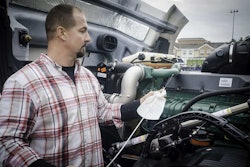The best time to start a regular PM program is when you’re buying your truck. If the dealer doesn’t volunteer detailed information on maintenance, ask for it. A good dealer is happy to give advice about oil changes, lubricant and filter replacement and other maintenance.
Take advantage of your leverage before you buy to get all the information you can. Manufacturers’ websites often offer detailed information.
Often, separate warranties are written on the engine, transmission and other components because they are supplied by different entities. Find out the duration of the warranties and what it will take to maintain their validity. You might want to consider extended warranties when available.
Choose a dealer carefully. Make sure its service department has the technicians and equipment to handle major repairs and that they have a helpful attitude. Talk to the parts and service managers and form a relationship. From there, take the same relationship-building approach to local tire and engine shops, an alignment shop and an air-conditioning shop.
Dealing with professionals who specialize in one maintenance item is key to holding costs down in the long term. Take time to let the service manager or even the owner of the shop know of your goals and plans. Ask their advice about maintenance scheduling.

Keep good records
Only with complete and accurate records can you track the work done on your truck and prove that required work has been done. Committing every shop visit to paper and creating a calendar of scheduled visits will pay off. You also should keep a schedule of future work to be done. This schedule will help you avoid overlooking something vital.
Devise your own maintenance service report and use it to keep a record of every dollar you spend on your truck. Keep receipts on repairs. Keep old parts in case of a warranty dispute.
When you use the truck service report, note all warrantable purchases and repairs, and include a record of your out-of-pocket expenses such as cab fares, meals and motel stays related to time lost due to repairs. Otherwise, you won’t be able to file warranty claims properly, and your profits will suffer.
Good maintenance records can help you determine average miles per gallon, expenses on a per-mile basis and other key benchmarks that are helpful in cutting costs. They also can help you spec your next truck.
[Related: Learning your engine's warning-lamp language]
Time to trade
Maintenance costs typically rise in the third and fourth ownership years. Fifth-year costs often drop because the truck needs certain work in its fourth year that isn’t required the next. However, the cumulative cost of maintenance -- your average cost per year since you took ownership -- and your cost per mile still increase each year.
No matter how rigorous your PM efforts, it's highly likely the time will come when you’ll spend more on maintenance than you would for a new truck. How will you know when that time comes? Your maintenance records will tell you.
Create a maintenance budget and track your maintenance expenses. When they rise to a point that seems excessive, check with your business services provider, who can help you determine how much your fuel, oil and maintenance costs have increased due to the truck’s age. Consult your insurance agent to help determine how an equipment upgrade will affect your premiums. Your financing source can discuss various options for the purchase of a new truck, and your accountant can explain potential depreciation benefits that would accompany a new purchase.
Industry experts say you should consider replacement when your fuel mileage drops 2 mpg or more despite conservation efforts, or if truck technology develops to the point that a new truck would get an additional 2 mpg. Another indication to trade is when total maintenance costs reach 15% of gross revenue.
As a rule of thumb, consider a new purchase when the principal, interest, maintenance and operating costs of an old vehicle are higher than the comparable costs attached to a new vehicle. The estimated resale value of the old vehicle, coupled with any manufacturer’s incentive on a new vehicle, may offset the higher cost of a new vehicle’s principal and interest. At this point, a trade makes sense.
Dealing with dealer service
Many longtime owner-operators have had at least a minor conflict with a dealer over a repair. Whatever the problem, never underestimate the need for effective communication, which can open the door for compromise in a dispute.
- Don’t just show up and demand instant service. You’re hardly the only one with a “hot load.” Make an appointment.
- Make accessible your complete service and warranty records, and never tell the dealer what to fix. Be as descriptive as possible about the problem’s history and answer all of a shop’s questions completely, adding pertinent details.
- If diagnosis is a problem, ask dealer personnel to discuss the issue with factory service people. If local technicians are too busy, call the factory representatives and ask them to assist the dealer or allow you to relay relevant information.
- When a problem is not identified readily, authorize an hour or two of labor for diagnosis. It’s cheaper than experimenting with repairs and more likely to yield results.
- If speaking to a service representative is a dead end, appeal to the service manager, dealer managers and ultimately the owner. Failing that, a factory representative might be able to influence the outcome. Understand that the manufacturer cannot force the dealer to do anything.
- Even if all else fails, suing can be expensive and is not likely to succeed unless the dealer clearly is violating the terms of a warranty, disobeying an applicable law or acting in bad faith.
More general tips:
- Work through the selling dealer, who has a greater motivation than other dealers to do warranty work or go to bat for you with the factory.
- Keep your cool and demonstrate a positive attitude. No one wants to cooperate when they’re treated rudely.
- Develop a good long-term relationship with dealer personnel. Your best leverage is having an established relationship combined with the option to take your business elsewhere.
Read next: Save money on maintenance with smart purchase practices and DIY acumen













